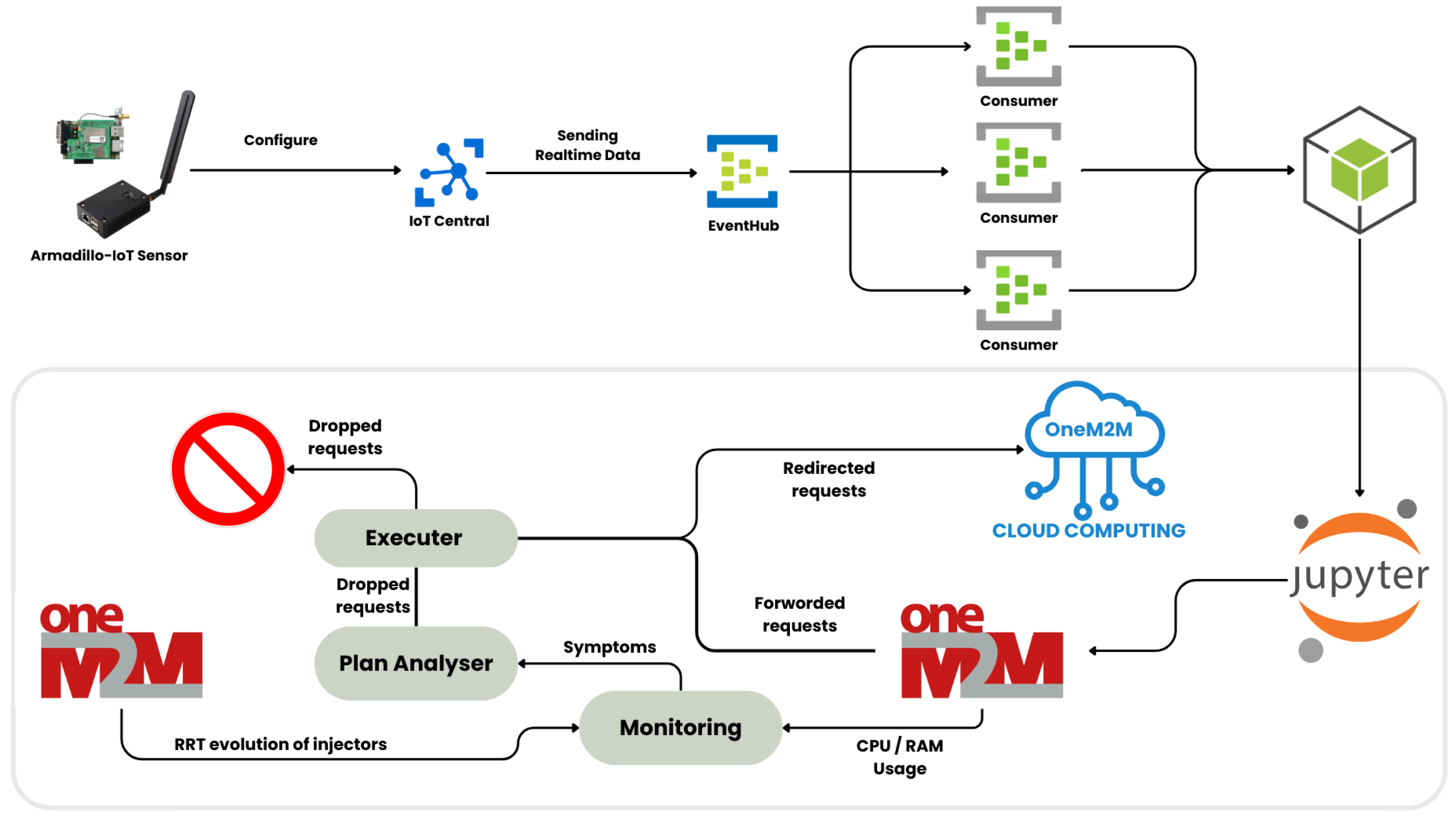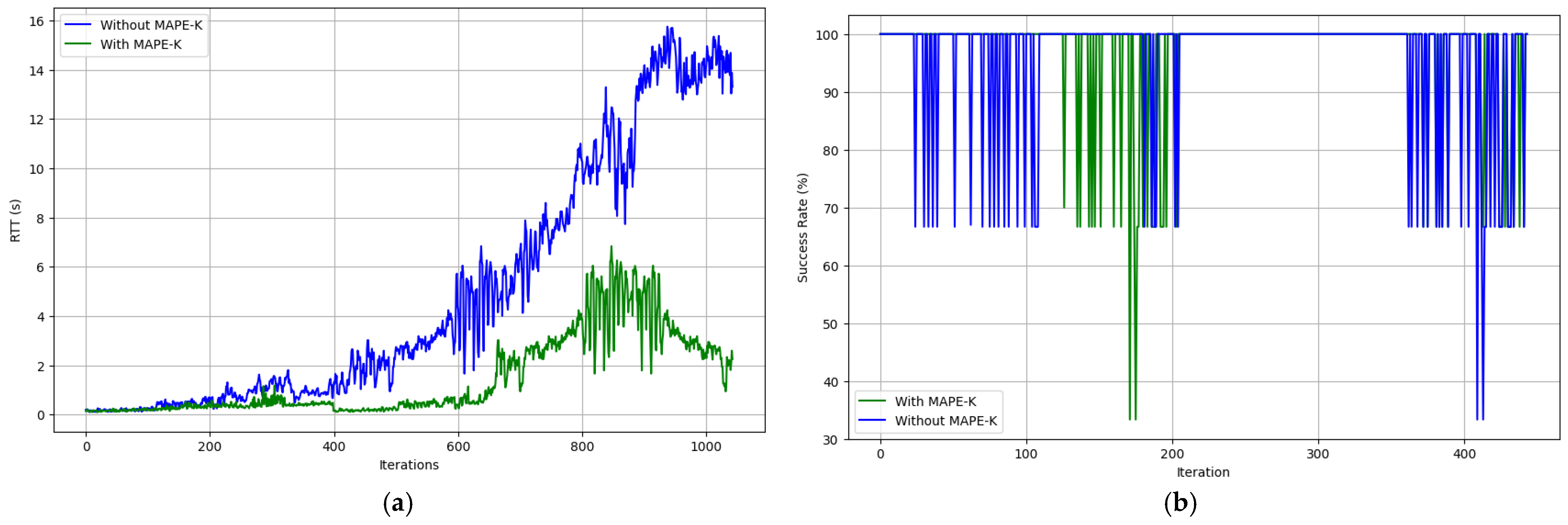Cost and QoS Analysis in IoT: An Optimization Approach Based on the OneM2M Standard †
Abstract
1. Introduction
2. Background and Related Works
3. Methodology
3.1. Managing Workload with MAPE-K Architecture
3.2. System Design

- Monitoring: Real-time RTT, CPU, and RAM utilization monitoring to detect indications of overload.
- Analysis: Detection of performance constraints and prediction of resource exhaustion.
- Planning: Suggesting a plan to migrate 25% of the load to cloud resources.
- Execution: Redirecting the traffic to a cloud instance, ensuring that the system recovers and still offers QoS.

3.3. Performance Evaluation and Cost Implications
- ►
- CPU Utilization: The decrease in CPU load on the OneM2M server following traffic diversion to the cloud.
- ►
- RTT (Round Trip Time): Enhancements in response latency so that RTT is kept under critical levels.
- ►
- Financial Implications of Cloud Resources: The financial implications involved in reassigning 25% of the workload to the Azure DC2s v2 instance.
3.4. Mathematical Modeling
- QoS Optimization Objective:
- ✓
- ✓
- ✓
- ✓
- Cost Optimization Objective:
- Combined Optimization:
- and are weighting factors that determine the trade-off between QoS and cost.
- Higher prioritizes QoS, while higher prioritizes cost reduction.
4. Results and Discussion
4.1. QoS Parameters
4.2. Cost Analysis
5. Conclusions and Perspectives
Author Contributions
Funding
Institutional Review Board Statement
Informed Consent Statement
Data Availability Statement
Conflicts of Interest
References
- Rahmani, A.M.; Bayramov, S.; Kalejahi, B.K. Internet of things applications: Opportunities and threats. Wirel. Pers. Commun. 2022, 122, 451–476. [Google Scholar] [CrossRef] [PubMed]
- Shouaib, M.; Metwally, K.; Badran, K. Survey on IoT-based Big Data Analytics. In Proceedings of the 13th International Conference on Electrical Engineering (ICEENG), Cairo, Egypt, 29–31 March 2022; pp. 81–85. [Google Scholar] [CrossRef]
- Et-Tousy, J.; Zyane, A. QoS in OneM2M: Performance Evaluation and Analysis. In Proceedings of the 4th International Conference on Electronic Engineering and Renewable Energy Systems—Volume 1 (ICEERE 2024), Saidia, Morocco; Springer: Singapore, 2025; Volume 1306. [Google Scholar] [CrossRef]
- Merseedi, K.J.; Zeebaree, S.R.M. The cloud architectures for distributed multi-cloud computing: A review of hybrid and federated cloud environment. Indones. J. Comput. Sci. 2024, 13, 1644–1673. [Google Scholar] [CrossRef]
- Pranavasri, V.J.S.; Francis, L.; Pal, G.; Mogadali, U.; Vattem, A.; Vaidhyanathan, K.; Gangadharan, D. Exploratory Study of oneM2M-based Interoperability Architectures for IoT: A Smart City Perspective. Authorea 2024, preprint. [Google Scholar]
- Internet of Things (IoT) Market Size, Share, and Trends 2024 to 2033. Available online: https://www.precedenceresearch.com/internet-of-things-market (accessed on 20 March 2025).
- Mutichiro, B.; Tran, M.-N.; Kim, Y.-H. QoS-Based Service-Time Scheduling in the IoT-Edge Cloud. Sensors 2021, 21, 5797. [Google Scholar] [CrossRef] [PubMed]
- Cao, L.; Huo, T.; Li, S.; Zhang, X.; Chen, Y.; Lin, G.; Wu, F.; Ling, Y.; Zhou, Y. Cost optimization in edge computing: A survey. Artif. Intell. Rev. 2024, 57, 312. [Google Scholar] [CrossRef]
- Andriulo, F.C.; Fiore, M.; Mongiello, M.; Traversa, E.; Zizzo, V. Edge Computing and Cloud Computing for Internet of Things: A Review. Informatics 2024, 11, 71. [Google Scholar] [CrossRef]
- Darwish, D. Emerging Trends in Cloud Computing Analytics, Scalability, and Service Models; IGI Global: Hershey, PA, USA, 2024. [Google Scholar]
- Silva, F.A.; Fé, I.; Gonçalves, G. Stochastic models for performance and cost analysis of a hybrid cloud and fog architecture. J. Supercomput. 2021, 77, 1537–1561. [Google Scholar] [CrossRef]
- Entrialgo, J.; Moreno-Vozmediano, R.; Díaz, J.L. Cost and response time optimization of edge architectures. Clust. Comput. 2024, 27, 7757–7773. [Google Scholar] [CrossRef]
- Zhou, J.; Pal, S.; Dong, C.; Wang, K. Enhancing quality of service through federated learning in edge-cloud architecture. Ad Hoc Netw. 2024, 156, 103430. [Google Scholar] [CrossRef]
- Et-tousy, J.; Zyane, A. A Comparative Study of HTTP and MQTT in OneM2M: A QoS Perspective. In Proceedings of the 9th Smart City Applications International Conference (SCA24), Tanger, Morocco, 2–4 October 2024. [Google Scholar]
- Et-tousy, J.; Zyane, A. Automated QoS Enhancement in OneM2M: Traffic-Oriented Approach for MQTT and HTTP Based on IoT SLA Variations. In Proceedings of theInternational Conference on Advances in Communication Technology and Computer Engineering (ICACTCE’24), Marrakech, Morocco, 29–30 November 2024. [Google Scholar]
- Azure IoT—Internet of Things Platform. Available online: https://azure.microsoft.com (accessed on 1 April 2025).
- Zyane, A.; Bahiri, M.N.; Ghammaz, A. IoTScal-H: Hybrid monitoring solution based on cloud computing for autonomic middleware-level scalability management within IoT systems and different SLA traffic requirements. Int. J. Commun. Syst. 2020, 33, e4495. [Google Scholar] [CrossRef]




| Domain | Success Rate | RTT |
|---|---|---|
| e-Health | >95% | Under 4 s |
| Industry | >50% | Under 10 s |
| Transportation | >20% | No specific requirement |
| Parameter | Description | Unit |
|---|---|---|
| RTTlocal | Round Trip Time for local processing | milliseconds (ms) |
| RTTcloud | Round Trip Time for cloud processing | milliseconds (ms) |
| SuccessRatelocal | Success Rate for local requests | Ratio (0–1) |
| SuccessRatecloud | Success Rate for cloud requests | Ratio (0–1) |
| CPUlocal | Local CPU utilization | Percentage (%) |
| CPUcloud | Cloud CPU utilization | Percentage (%) |
| RAMlocal | Local RAM usage | Megabytes (MB) |
| RAMcloud | Cloud RAM usage | Megabytes (MB) |
| Parameter | Description | Unit |
|---|---|---|
| CVM | Hourly cost of the cloud virtual machine | USD/h |
| Cdata | Cost of data transfer to the cloud | USD/GB |
| Clocal | Operational cost of local infrastructure | USD/h |
| Toffload | Time spent offloading traffic to the cloud | Hours |
| Vdata | Volume of data transferred to the cloud | Gigabytes (GB) |
| Parameter | Description | Range/Value |
|---|---|---|
| Poffload | Percentage of traffic offloaded to the cloud | 0 ≤ Poffload ≤ 1 |
| Plocal = 1 − Poffload | Percentage of traffic processed locally. | 0 ≤ Plocal ≤ 1 |
| Cost Component | Cost Before Optimization (USD) | Cost After Optimization (USD) | Cost Reduction (%) |
|---|---|---|---|
| Cloud VM Cost | 57.6 | 50.69 | 12 |
| Data Transfer Cost | 26.1 | 20.1 | 23 |
| Azure IoT Hub Cost | 25 | 25 | 0 |
| Support Cost | 15 | 15 | 0 |
| Total Cost | 123.7 | 110.79 | 10.44 |
Disclaimer/Publisher’s Note: The statements, opinions and data contained in all publications are solely those of the individual author(s) and contributor(s) and not of MDPI and/or the editor(s). MDPI and/or the editor(s) disclaim responsibility for any injury to people or property resulting from any ideas, methods, instructions or products referred to in the content. |
© 2025 by the authors. Licensee MDPI, Basel, Switzerland. This article is an open access article distributed under the terms and conditions of the Creative Commons Attribution (CC BY) license (https://creativecommons.org/licenses/by/4.0/).
Share and Cite
Et-Tousy, J.; Abourriche, S.; Zyane, A. Cost and QoS Analysis in IoT: An Optimization Approach Based on the OneM2M Standard. Eng. Proc. 2025, 112, 19. https://doi.org/10.3390/engproc2025112019
Et-Tousy J, Abourriche S, Zyane A. Cost and QoS Analysis in IoT: An Optimization Approach Based on the OneM2M Standard. Engineering Proceedings. 2025; 112(1):19. https://doi.org/10.3390/engproc2025112019
Chicago/Turabian StyleEt-Tousy, Jamal, Samira Abourriche, and Abdellah Zyane. 2025. "Cost and QoS Analysis in IoT: An Optimization Approach Based on the OneM2M Standard" Engineering Proceedings 112, no. 1: 19. https://doi.org/10.3390/engproc2025112019
APA StyleEt-Tousy, J., Abourriche, S., & Zyane, A. (2025). Cost and QoS Analysis in IoT: An Optimization Approach Based on the OneM2M Standard. Engineering Proceedings, 112(1), 19. https://doi.org/10.3390/engproc2025112019






